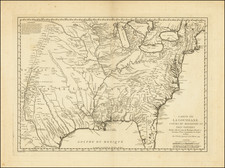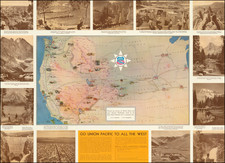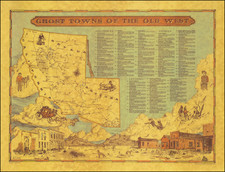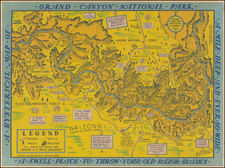The only recorded example of the privately printed first edition of this rare map of the Cherokee Strip in Indian Territory, identifying the lands available for homestead claims during the Cherokee Strip Land Run of 1893.
The present map, dated September 4, 1893 and signed by Chas. Smith (see below), is apparently an unrecorded first privately printed edition of Wiggins' map of the Cherokee Strip. A second edition, with the date of September 8th, 1893 is known in 3 examples and was the source wich was copied for a later US Congressional document entitled Letter From the Secretary of War . . 53d Cong., 1st Sess. House. Ex.Doc. No.27. and printed by the Government publishing office in on November , 1893. The map included a copy of the Wiggins map entitled Sep 8th 1893. Map of the Cherokee Strip compiled from U.S. Surveys by E.W. Wiggins, C.E. published by The Western Litho. Co. ... Wichita, Kan.
As can be seen by comparing the titles, the present map pre-dates by 4 days the second privately printed edition of the map. The other primary difference between this map and the map which accompanied the Letter From the Secretary of War . . . is the extra table to the left of the Rock Island Railroad Promotional Table (which appears only on the first edition), entitled "How To Tell Your Section Corners," and gives a primer for determining the location of Sections, as offered by the Government and identified on the map.
The Cherokee Outlet, more often referred to as the Cherokee Strip, was located in what is now the state of Oklahoma. It was a 58 x 225 mile strip of land south of the Oklahoma-Kansas border between the 96th and 100th meridians. The acutal Cherokee Strip was a two mile strip running along the northern border of much of the Cherokee Outlet and which was the result of a surveying error. In 1828 and 1835, the Government granted seven million acres to the Cherokee Nation. The Government guaranteed to the Cherokee that this land would be a perpetual outlet west for tribal hunting grounds. After the Civil War, because part of the Cherokee Nation had fought for the Confederacy, the government demanded a new treaty. They reduced the original reservation lands and permitted so-called "friendly tribes" to be moved into the eastern end of the Outlet.
With the start of the cattle drives following the Civil War, the Cherokee used their western land to make a profit. The cattlemen wanted to fatten their cattle on the rich grasses before taking them to railheads in Kansas so they leased land from the Cherokee. Settlers viewed the cattlemen's use of this area as a waste of fertile farmland and pressured the government to purchase the Cherokee land. Congress eventually paid $1.40 per acre for the land and announced the opening of the Outlet to homesteaders. President Grover Cleveland designated September 16, 1893, as the date for the run for the 6 million acres.
On September 16, 1893, 100,000 prospective settleers gathered for the land run into the Cherokee Outlet by horse, train, wagon, and even on foot, hoping to claim one of the over-40,000 quarter sections. At noon September 16, 1893, a shot rang out and more than 100,000 determined settlers raced for 42,000 claims. By sunset, farms were being established, and the cities of Enid, Perry, Alva, and Woodward had been populated. There were endless lines at federal land offices and more losers than winners.The Cherokee Strip Land Run was a tumultuous finale to what many have called the last American frontier.
The map covers include the name Chas. Smith in pencil. A Charles Smith of Whitehall, Virginia is known to have relocated to Missouri and later to Texas in the 1860s and 1870s, prior to the land run. In 1892, he relocated to Oklahoma City, where he bought the city livery business and its stock, before making the run on September 16, 1893. An interview with his son Robert W. Maupin notes:
His second run was for a homestead in the Cherokee Strip Opening, September 16, 1893. Father with three other men, selected a section of land from the map and had the location in their mind. Father hitched two of his fastest horses to the buckboard and he and his three friends made the run for this section of land which was Section 35, Township 22, Range 1 West. They started two miles from Orlando. Father and Chas. Brant were in Father's buckboard and the other two were horseback. They all drove and rode as fast as they could until they reached Cow Creek and there Father and Mr. Brant unhitched the horses from the buckboard. The horses had soft saddles on them and Father and Mr. Brant left their buckboard at Cow Creek and rode these horses to the place they selected. All filed on their land without trouble except Father. A man named Petter contested Father's claim but he bought him off. Gave him five of his lots at Cloud Chief and $150.00 each.
While it is impossible to confirm that this is the same Charles Smith, we were not able to locate any other Charles Smith who participated in the Cherokee Strip Land Run. We were also able to locate a shop keeper in Wynnewood by the name of Charles Smth, who set up shop in 1896, possibly the same person.
The map is of the utmost rarity and this September 4, 1893 edition may by a unique survival. While OCLC locates 3 examples of the September 8, 1893, privately printed example of the map, there are no recorded examples of the map with the earlier September 4, 1893 imprint. It also appears that the extra table may have been removed from the September 8, 1893 privately printed edition.











![Louisiana [Large-Paper Example]](https://storage.googleapis.com/raremaps/img/small/83278.jpg)


![[Run of 6 Volumes] Report Upon Geographical Surveys West of the 100th Meridian](https://storage.googleapis.com/raremaps/img/small/74064.jpg)